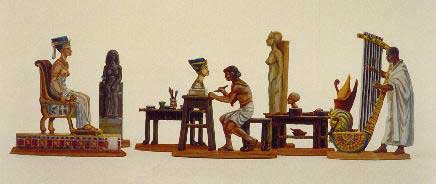(figure:Neckel)

(figures: Neckel)
| PRESENTAZIONE | PRESENTATION |
| Una volta realizzati o acquistati i piatti, bisogna trovare un modo degno di esporli. Ci sono diversi modi per presentare i soldatini piatti: vetrina, quadro, diorama, ecc. |
Once you have
your painted flats, you must
find a way to exhibit them
worthy. There are several ways to exhibit flat figures: showcases, frames, dioramas, etc. |
| Vetrina la soluzione più semplice è quella di metterli in una vetrina. Si possono trovare vetrine già fatte presso costruttori specializzati (che di solito si trovano alle diverse fiere di modellismo) oppure presso grandi magazzini di mobili. Qualcuno, più raffinato, può farsela fare su misura dal proprio falegname. In generale, è inutile che la vetrina abbia una grande profondità in quanto i soggetti esposti verso il fondo rimangono nascosti. I ripiani sarebbe meglio fossero di vetro (anche se risulteranno più pesanti): infatti la luce potrà passare più facilmente tra un ripiano e l'altro. |
Showcase
|
| Quadro Questa soluzione si presta per una piccola serie. In pratica, si fissano i piatti su un fondo di cartone rivestito di carta vellutata autoadesiva (cartolerie o negozi de belle arti) oppure con cartoncino colorato con eventuali scritte o didascalie. Su questo fondo si praticheranno degli intagli in corrispondenza delle basi dei soldatini. Il tutto poi verrà inserito in una cornice di stile antico o moderno secondo il soggetto o i propri gusti. Attenzione: prevedere tra il fondo ed il vetro della cornice un piccolo spessore di 8-10 mm (ingombro delle basi dei soldatini). |
Picture frame
|
| Diorami E' il sistema di presentazione di maggiore effetto ed è quello che si incontra nei musei per la ricostruzione di episodi storici o di battaglie. Chi è dotato di particolare gusto per la scenografia, ha di che divertirsi. Nei musei si possono trovare diorami con decine di migliaia di pezzi (per es. nel museo militare di Ingolstadt, Germania); in generale però nessuno ha a disposizione tanto spazio e ci si deve accontentare di progetti meno ambiziosi, che però possono risultare molto più belli e descrittivi. Vediamo ad esempio nelle immagini che seguono alcuni esempi di diorami, partendo dai più semplici; i diorami sono stati realizzati da Alfredo Podestà di Genova, specialista in questo campo (Email: alfredo.podesta@tin.it). |
Dioramas We see for example in the following pictures some dioramas, starting from the most simple up to really intricated dioramas (all dioramas here shown have been made by Alfredo Podest�, a specialist in this field -Email: alfredo.podesta @ tin.it).
|
| Diorama "Odissea"-( Figure: Retter)
Questo
è un diorama complesso a scene interconnesse, che racconta alcuni episodi
dell’Odissea, amalgamati in una unica rappresentazione. E’ un po’ come una
storia a fumetti, però seza soluzione di continuità, una scena fondendosi e continuando
nell’altra. Le figure, le onde in primo piano e gli scogli sono di produzione Retter. Sono invece
stati costruiti dall’autore: Scilla, isola di Circe, nuvole di sfondo e tutto il
gruppo di Eolo.
|
 |
"The Odyssey"
Diorama -
(Figures:
Retter) This is a complex diorama with interrelated scenes and tells some episodes of the Odyssey, blended into a unique representation. It 's a bit like a comic book, but without interruption, a scene merging and continuing in the other. In particular, starting from the left, are represented episodes of the Cyclops Polyphemus, Scylla and Charybdis, the Sirens, Circe the Sorceress and (top right) Aeolus God of the winds. The figures, the waves in the foreground and the rocks are produced by Retter. The parts constructed by the author are: Scylla, Circe's island, clouds background and the whole group of Aeolus. The diorama is part of a group of two, with all the story of the Odyssey |